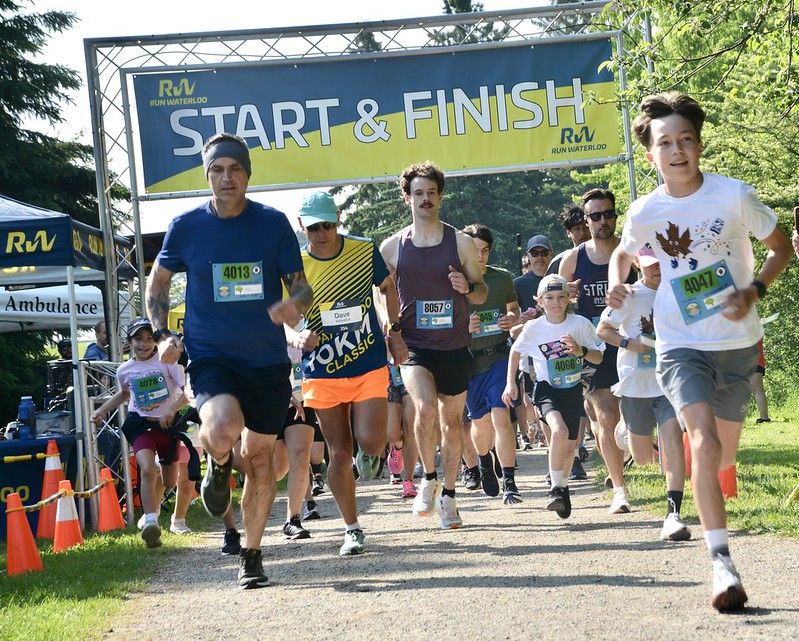How long until we officially race again? I would say probably at least a few weeks, wouldn’t you? While I’m sure many of you miss toeing the line, there are some positives. For instance, one of the best ways to take advantage of this extended offseason is to work on weaknesses that are normally tough to address.
Constantly acting in A-race mode, followed by tapering, followed by recovering can definitely result in short term spikes in performance. But often the long term, gradual development is sacrificed.
A great way to take a swing at improving your baseline ability to perform is a full strength program. However, it is not as logical to include when in close proximity to an A-race. If you’re anything like me, you’ve thought of introducing more strength work throughout the pandemic. If you’re not like me, you’ve actually done it- good for you, you jerk!
The questions that I get from the team on this topic are endless. I have written about the topic in short before such as here. However, I thought it was finally time to take a deep dive into strength training for endurance athletes.
How, when, heavy vs. light, high rep vs. low rep, plyometrics vs. slow, what demographics respond better, how much, what are the possible negative outcomes? I will try to address all of these throughout a series of about 5 articles over the next number of weeks.
Since there is so much pseudoscience and anecdotal evidence that floats around in the world of strength training, I am also going to take a look at the mechanisms of action of strength training to help guide your decision making and your ability to sift through the different opinions you may encounter. Taking the time to understand these basics will go a long way in helping you take the right advice and discard the rest.
Does it work?
So does strength training make endurance athletes faster? In short, if it’s done blindly without the right strategy, it can make you faster, slower or do nothing. For the right person and event, with the right strategy, it can definitely help to improve performance.
Mechanisms of Action
When we consider endurance performance, there are several different physical parameters that we try to improve to influence overall performance. The interesting thing is that different types of training can influence each one of these parameters differently, which is why you see such a variety of intensities and durations of workouts; you don’t just run a lot at marathon pace to become a faster marathoner!
While there are many nuances, the three key detriments of performance are (1) V02max (maximum ability to consume oxygen), (2) Economy (how efficiently you use that oxygen), and (3) Lactate threshold (the point where lactate from anaerobic respiration really starts to build up).
Over the next three articles, I will discuss each one of these in relation to endurance performance and if strength training impacts them. The first one- V02max- is what we will begin with today.
V02max
As many of you know, V02max is a measure of the maximal ability to consume oxygen expressed per unit of time, per kg of body weight. The more you can consume per kg of body weight, the better it is for an endurance athlete.
It’s important to note that the highest V02max does not predict who will win a race by any means. Factors such as economy (how efficiently you use that oxygen) can cause an athlete with a lower V02max to beat an athlete with a higher V02max. However, to be among the best, your V02max must be at least very high. And, to be at your personal best, maximizing your V02max is the way to go.
Now the question becomes: Can strength training help with this? Let’s look at the research.
In Runners:
One study published in 2006 looked at the influence of plyometrics (i.e. jump training) for 9 weeks in 15 well-trained runners. After the 9 weeks, the athletes showed signs of a higher level of performance, but did not show any increase in their ability to consume oxygen. One interesting factor was that these athletes already had a fairly high V02max- 71.1ml/kg/minute (whereas an average sedentary man is in the 35-40ml/kg/minute. These were elite-ish level runners!
So what about less-elite people? Does strength training help to improve your V02max? In a 2011 study, 27 recreational runners were put through an 8-week bout of strength training; either heavy resistance, plyometrics or higher rep endurance-type training. Long story short: was there a performance improvement? Yes. Was there any change in ability to consume oxygen? No!
In Cyclists:
Both well-trained and recreational runners didn’t see an improvement in oxygen consumption with concurrent strength training, but what about other endurance sports, like cycling? In this 2009 study, a group of well-trained cyclists went through a 6-week resistance training plan. In the end, 30K TT times and sprint performances did not improve. When it came to V02max, they saw an average V02max of 62.4 before and 62.3ml/kg/min after the 6 weeks- no change.
So if you don’t get faster, it makes sense that the V02max would also not improve. What about the cases where cycling performance improves with resistance training? In another study, a deeper dive was taken on this subject with cyclists. In this case, 16 weeks of resistance training was completed, and many more outcome measures were evaluated including muscle fibre changes and capillarization along with the usual performance measures and V02 measurements. In this study, there were spikes in performance including improved 5-minute and 45-minute TT tests. However, once again, the V02max of the subjects remained completely unimpacted by the resistance training.
In Skiers:
Heck, even when we look at Nordic skiing, it’s the same thing. With a sport that’s so dependent on full-body strength, I’ve often heard people say that strength work allows them to push harder (and possibly, therefore, consume more oxygen). In this 2012 study, Nordic skiers went through a 12-week resistance training plan on top of their usual training. In the end, they saw many changes directly related to the muscles targeted, such as improved jump performance. But, in the end, there wasn’t any improvement in endurance performance or V02max. Even on the economy side of things, there was no improvement.
When it comes down to it, strength work simply doesn’t improve oxygen consumption in somebody who is highly or partially trained for an endurance sport of any type (most of the time).
Practical Applications:
So, long story short, whether it be plyometrics or heavy, low rep strength training, neither seem to improve an athlete’s ability to consume oxygen. This may not be a surprise to some, but others might be a little shocked. After all, when we lift weights, we definitely do see spikes in HR- does that spike not make our bodies better at consuming oxygen? The value of these studies is we definitively know the answer to this question is, ‘not really. ‘
While that doesn’t mean strength training does not help improve endurance performance, this information is valuable in that it can help evaluate when and how to implement strength training. The bottom line is, when you are attempting to improve your ability to consume oxygen, you need a lot of time with the HR elevated along with a fair amount of time with the HR evaluated even more. In general, to be a better endurance athlete, that means spending more time with your effort in the aerobic zone with about 20-30% of your week at some sort of sustained intensity. Strength training allows for short-lived spikes, but the total time spent with an elevated HR is very low when compared to just going for a slow jog.
For many runners, this sustained time with an elevated HR will look like 60-70K/week, consisting of about 15K of quality with the rest being aerobic, easy running over the course of 6-8 hours.
How does this information help?
How does the knowledge that strength training does not improve our oxygen consumption help us to make training decisions? When you look at the type of athlete you are, the type of activity you’ve historically done, what your goals are and what you feel your limiting factor is on race day, deciding when to take out or add in strength training becomes more clear when you know what it’s doing for you.
For instance, if you’re a long-term, high-mileage runner who has been running over 100K+/week with 2-3 quality session/week for months stacked on top of many years of doing the same, there’s a very good chance you have maxed out your V02max long ago. Couple this with the thought that you feel leg cramping, a sense of getting sloppy with your stride, or leg weakness holding you back as opposed to your low energy or “breathing” in races, then it might make sense that strength work may help you. This is especially true if you can maintain your current training load while also adding the strength work on top. (Disclaimer: looking sloppy and actually becoming less economical are very different things- read more here).
On the other end of the spectrum, if you are new to running with a background in another sport that involved 3-4 strength sessions/week, you have been running 30-40K/week for about 8 weeks, and have a goal of improving your 5K time, the direction you would take is different. There’s a good chance that with this type of training you already have fairly decent neuromuscular adaptations from your history with resistance training, while you haven’t even begun to tap into your full aerobic abilities.
Even though a 5K seems short, well over 80% of our energy during a race like this comes from aerobic respiration. In fact, on average, the 600m race is the cut off where we see an equal contribution from aerobic and anaerobic respiration. The more time you spend with your HR elevated, the more you will trigger aerobic adaptations like an increased stroke volume (volume of blood pumping from your heart) and capillary density (oxygen-transporting blood vessels penetrating our muscles). So for this type of athlete, we almost certainly would cut back on the strength work and use that extra time and energy to up their mileage.
Why not do both you ask? There’s an argument for that, and it totally depends on the athlete’s goals. However, if the singular goal is to run a faster 5K, having less beat up legs from strength work will result in more running time and a resultant better ability to consume oxygen…and a faster time!
So there you have it! This just a drop in the bucket of understanding the physiological impact of strength training on endurance athletes. If you do not feel you completely understand how and when to implement it, you’re probably thinking about things properly- this is just a start! Strength training most definitely is beneficial for the right endurance athlete when completed at the right time in the right way. Stay tuned for more in the coming weeks as we piece everything together in relation to lactate threshold, economy, possible detrimental effects and the principles of how incorporate it!






